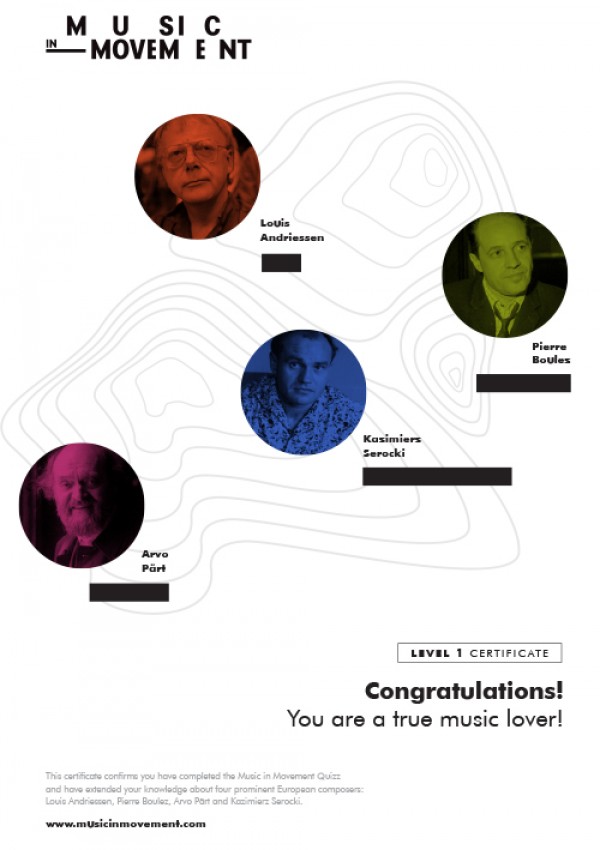MiM quiz – Expert level / Education
Remember, this quiz is not about testing your knowledge about contemporary music. It's all about getting to know the four composers - their music, techniques, but also inspirations and private stories. We invite you to take on this challenge - discover the universe of four personalities and dive in into their music.
With whom did the four composers study?
Arvo Pärt studied composition in Tallinn with e.g. Veljo Tormis, a composer known primarily for his choral compositions.
The eminent Italian composer Luciano Berio was young Louis Andriessen’s composition professor in 1962–1964.
In the same period, also in Paris, Olivier Messiaen conducted his famous analysis class – his broad horizons, unconventional interests and openness attracted many composers, including Pierre Boulez, who several years later became leading figures of the European avant-garde.
Nadia Boulanger (1887–1979) was a teacher of many outstanding composers, including Kazimierz Serocki, who in 1947–1948 explored the secrets of composing under her guidance thanks to a scholarship he had been granted.
20th- and 21st-century composers would often explain their composition techniques and engage in more general theoretical reflections
Many published books or articles; some conducted lectures at universities or courses, sometimes also commented on their works during encounters with non-expert audiences. But there were also those who did not comment on their oeuvres, assuming that music spoke for itself.
He published many books on music written by himself and other composers (especially 20th-century composers). In addition to educational and theoretical work addressed to specialists (composers, musicians, theorists), he devoted a lot of attention to providing comments on contemporary works for concertgoers, including young people.
He lectured in composition at conservatories and courses for young composers. He wrote one book – but he did not devote it to his own oeuvre but to the music of a composer that was artistically particularly close to him.
He did not give interviews and was reluctant to comment on his own oeuvre. He included his reflections on the foundations of his music in several hitherto unpublished lectures.
He did not write about his own music, but in interviews and numerous contributions on various occasions he said a lot about it.
In which example is the sound of instruments transformed electronically?
Choose one or more:
Pierre Boulez – …explosante-fixe… for MIDI flute, two flutes, ensemble and electronics (1991–93).
Louis Andriessen – De Tijd for choir and orchestra (1980–81). Louis Andriessen sometimes used electronics, but the sophisticated colours and effects in the piece are achieved without electronics.
Kazimierz Serocki – Pianophonie for piano with electronic transformation of sound and orchestra (1979).
Arvo Pärt – Miserere (1989–92). Arvo Pärt did not use electronics, the reverberation is, of course, entirely natural.
Here are some names of performers important to the four composers for some reason. Link them to the right name.
The conductor Reinbert de Leeuw, together with the Dutch ensembles Schönberg Ensemble and Asko Ensemble (now combined into one Asko/Schönberg Ensemble) performed and premiered many of Louis Andriessen’s works.
Maurizio Pollini is a brilliant interpreter of Pierre Boulez’s piano sonatas, especially No. 2, which he believes is a milestone in the repertoire for the instrument on a par with Beethoven’s sonatas.
Gidon Kremer is a great advocate of Arvo Pärt’s music – at his request the composer wrote Tabula Rasa; Kremer was also the first performer of Fratres in the version for violin and piano.
Les Percussions de Strasbourg premiered Kazimierz Serocki’s percussion sextet Continuum.
Creative periods - Pierre Boulez
Which work by the composer is earlier? Which is later?
The earlier one should be indicated.
Discreet use of live electronics (delay, reverb diversification) points to a later period of Pierre Boulez creations, associated with the IRCAM technology (Dialogue de l'ombre double, 1985). In the case of Le marteau sans maître (1954), the earlier date is indicated, inter alia, by the melody characteristic for the avant-garde of the 50s.
Well done!
We hope you enjoyed the experience!
You can now share & save your MiM certificate!

